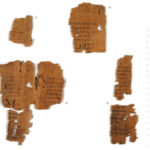| Artefact ID | 493 |
| TM ID | TM 64415 |
| Findspot (DEChriM ID) | 30 (al-Ašmūnayn) | Class | Textual |
| Material | Papyrus |
| Writing medium | Codex |
| Text content | Literary |
| Language | Greek |
| Description | PSI I 6+7; Studi Religiosi 6 (2) (1906): 129-140; Ap5 + Ap18 Papyrus fragments comprising different folios from the same codex. One set of fragments (PSI I 7) contains the end of the Apocalypse of Elias, and the other (PSI I 6) contains the Protevangelium of James 13-15 and 17-23. PSI I 6 is a collection of 5 fragments from consecutive folios: Its original size is estimated to have been 20 x 18 cm with 23-24 lines per page. Some of the original binding is visible (i.e., the remnants of an attached cord). The ed. pr. suggests that this sequence of folios belonged to a 24-page fascicle of 8 folios originally; see Wayment 2013: 75. The text is the Protevangelium of James 13:1-23:3 concerning the birth of Mary and Jesus and the apocryphs of Zacharias and Joseph. The content overlaps heavily with P.Bodmer V (Protevangelium of James; 4th c. Panopolis). The text contains one nomen sacrum (for Israel in fr. E l. 6 recto), as well as lectional aides such as diaereses and the diastole. Punctuation occurs in the shape of a high point. PSI I 7 consists of a fragment measuring 6.5 x 6.5 cm, with an estimated original size of 20 x 18 cm (same codex as PSI I 6); see Van Haelst 1976: 199. There are 5 fragmentary lines of text on the recto, which contain an unknown Christian text (probably apocryphal). The verso preserves 7 lines of the Apocalypse of Elias. |
| Selection criteria | Literary genre (Non-canonical), Nomina sacra |
| Date from | 350 |
| Date to | 450 |
| Dating criteria | Palaeography. Dated by the ed. pr. to the 4th c. A date in the second half of the 4th c. has been suggested by Crisci and Degni 2002: no. 55, while Wayment 2013: 75 places it in 4th/5th c. |
| Absolute/relative date | Relative date |
| Archaeological context | PSI I 6 and 7 were found in al-Ašmūnayn (Hermoupolis Magna) during the excavations of E. Breccia and G. Biondi in 1904. |
| Accession number | Florence, Biblioteca Medicea Laurenziana, inv. 13729 + 13730 |
ARTEFACT IDENTIFIERS
Reference editions:
• Pistelli, Ermenegildo. 1912. Papiri greci e latini I, edited by G. Vitelli and M. Norsa. Florence, 9-15, no. 6. and pl. 1.
• Pistelli, Ermenegildo. 1912. Papiri greci e latini I edited by G. Vitelli and M. Norsa. Florence, 16-17, no. 7.
Editio princeps:
• Pistelli, Ermenegildo. 1906. "Papiri evangelici". Studi religiosi diretti da S. Minocchi 6 (2), 129-140.
Additional bibliography:
• Aland, Kurt. 1976. Repertorium der griechischen christlichen Papyri: 1. Biblische Papyri: Altes Testament, Neues Testament, Varia, Apokryphen. Apokryphen 5 and 18.
• Carlini, A. 1998. "Papiri cristiani e tradizione dei testi biblici e patristici". Scrivere libri e documenti nel mondo antico (Pap. Flor. 30). Florence, 25-26.
• Crisci, Edoardo. 2004. "I più antichi codici miscellanei greci. Materiali per una riflessione". Segno e Testo 2. 138-139, plate no. 15.
• Crisci, Edoardo, ed. 2002. Papiri letterari della Biblioteca Medicea Laurenziana di Firenze. Cassino: Università degli studi di Cassino, no. 55.
• Frankfurter, David. 1993. Elijah in Upper Egypt. Minneapolis.
• Naldini, Mario. 1965. Documenti dell'antichità cristiana : papiri e pergamene greco-egizie della Raccolta Fiorentina. Florence: F. Le Monnier. 20-21, records no. 22 and 25 and plate no. 15.
• Steindorff, Georg. 1899. Die Apokalypse des Elias. Leipzig. 105 (§5-13).
• Strycker, Émile de. 1980. "Die griechischen Handschriften des Protevangeliums Iacobi". Griechische Kodikologie und Textüberlieferung. Harlfinger, D, ed. Darmstadt. 577-612.
• Strycker, Émile de. 1961. La forme la plus ancienne du Protévangile de Jacques. Bruxelles: Société des Bollandistes.
• Tischendorf, Constantin von. 1876. Evangelia apocrypha. Leipzig.
• van Haelst, Joseph. 1976. Catalogue des papyrus littéraires juifs et chrétiens. Paris. Description no. 568 and 600.
• Wayment, Thomas A. 2013. The text of the New Testament apocrypha (100-400 CE). London. 75-78 and 283-284.


 Json data
Json data





